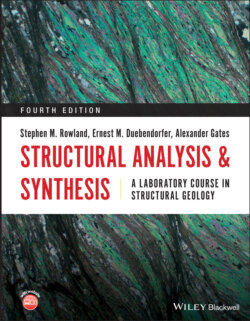Читать книгу Structural Analysis and Synthesis - Stephen M. Rowland - Страница 12
Definitions
ОглавлениеThe following terms are used to describe the orientations of lines and planes. All of these are measured in degrees, so values are typically followed by the degree symbol (°).
AttitudeThe orientation in space of a line or plane. By convention, the attitude or orientation of a plane is expressed as its strike and dip; the attitude of a line is expressed as trend and plunge. (syn: orientation).BearingThe declination or horizontal angle between a line and a specified coordinate direction, relative to compass directions or in azimuth.StrikeThe bearing of the line of intersection of an inclined plane with the horizontal plane or surface (Figure 1.1). The strike is a line of equal elevation on a dipping plane.DipThe vertical angle between an inclined plane and a horizontal line perpendicular to its strike. The maximum angle of inclination on an inclined plane. The direction of dip can be thought of as the direction water would flow down the plane (Figure 1.1).TrendThe bearing (compass direction or declination) of a line (Figure 1.2). Non‐horizontal lines trend in the down‐plunge direction.PlungeThe vertical angle of inclination between a non‐horizontal line and the horizontal (Figure 1.2).PitchThe angle measured within an inclined plane between a horizontal line and the line in question (Figure 1.4). Also called rake.Apparent dipThe vertical angle between an inclined plane and a horizontal line that is not perpendicular to the strike of the plane or in true dip direction (Figure 1.2). For any inclined plane, the true dip is always greater than any apparent dip. Note that an apparent dip may be defined by its trend and plunge or by its pitch within a plane.
Figure 1.4 Pitch (or rake) of a line in an inclined plane.
